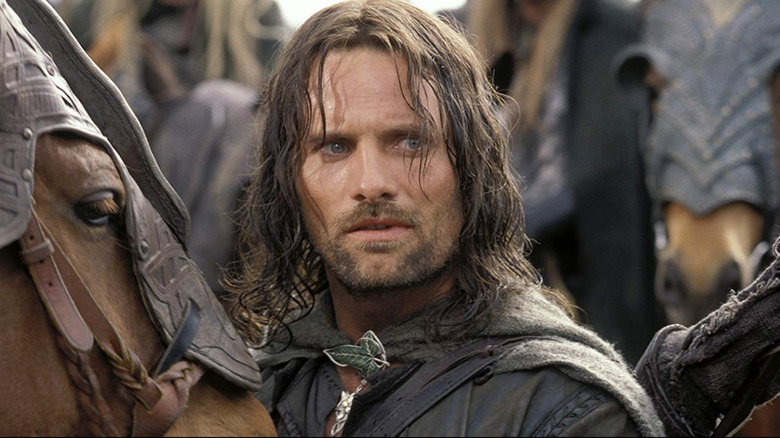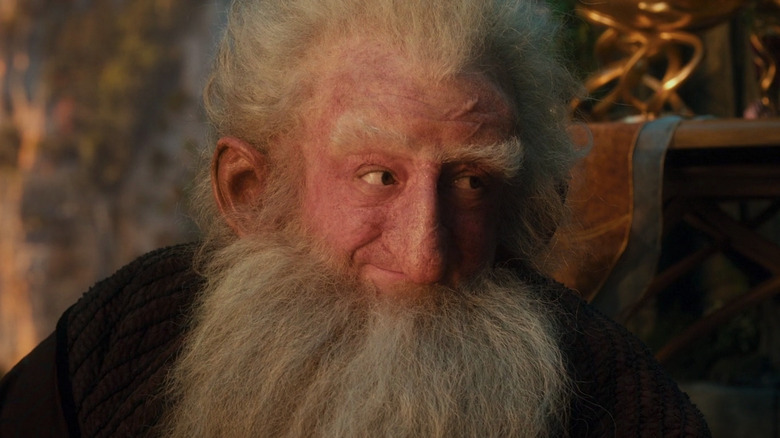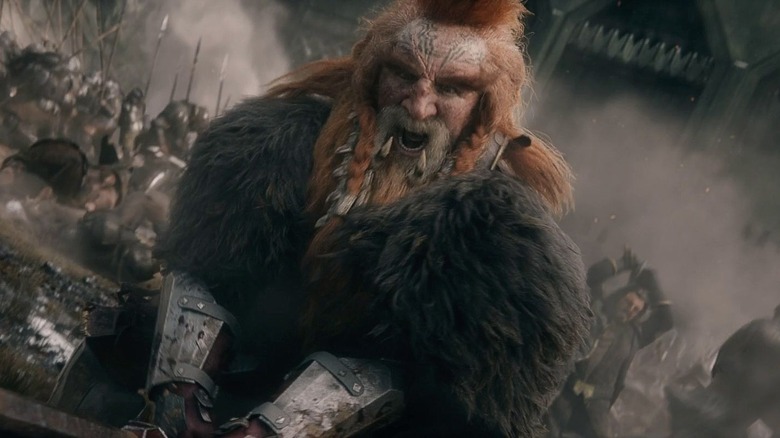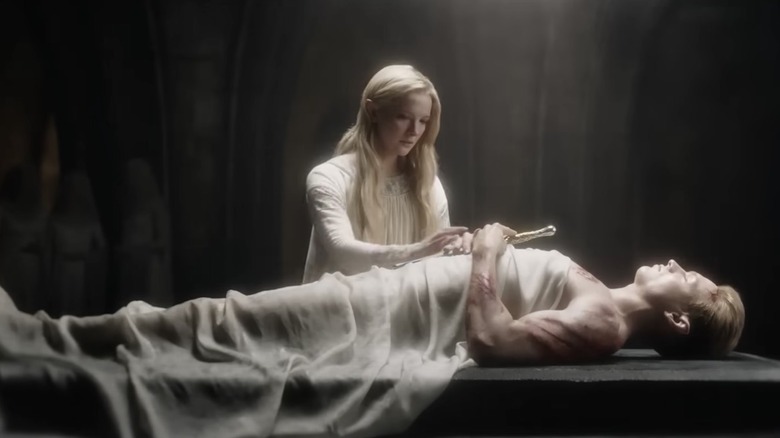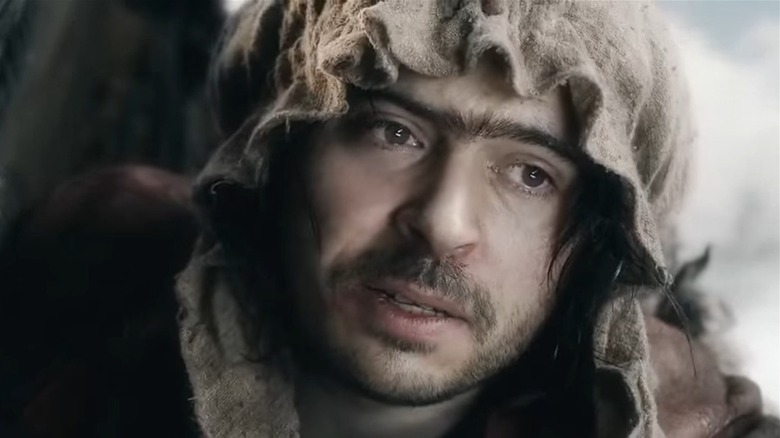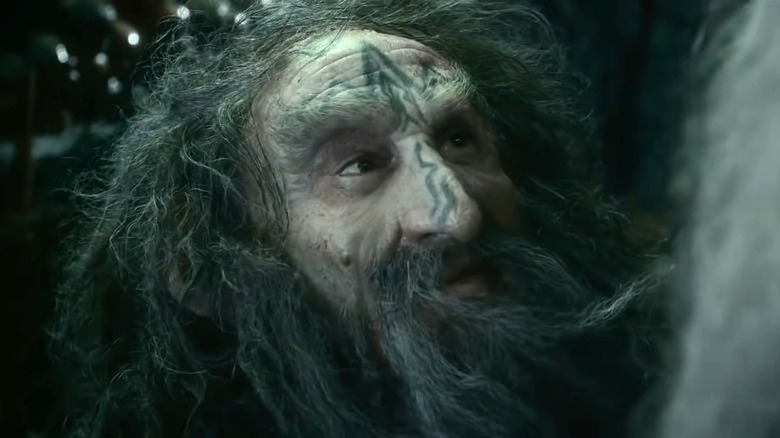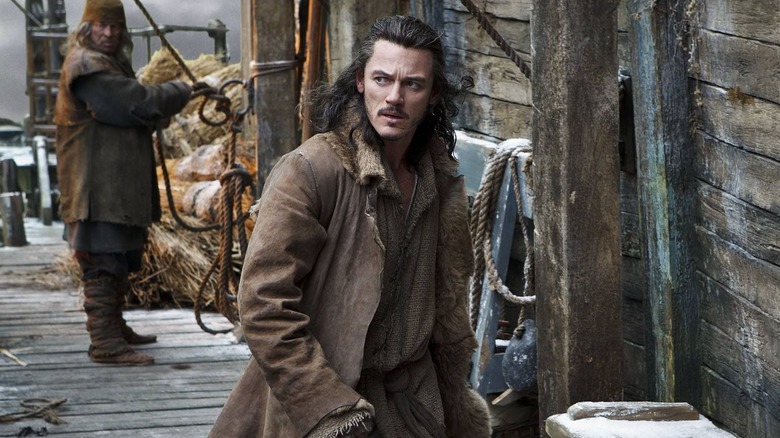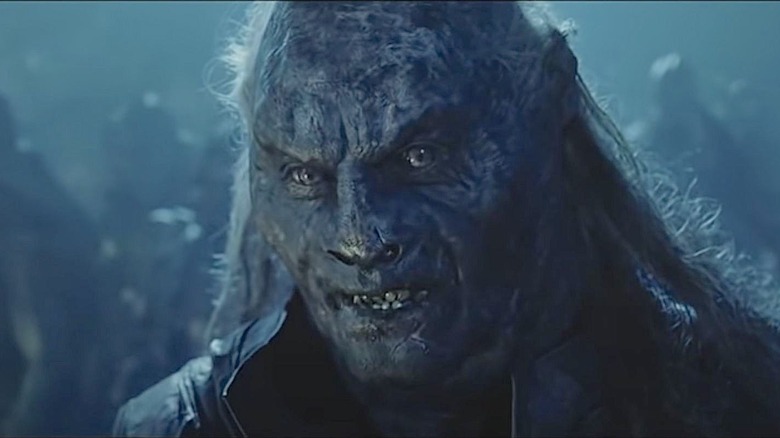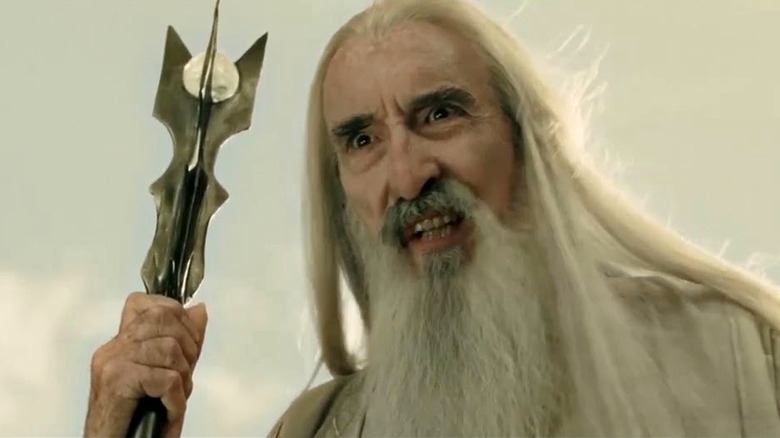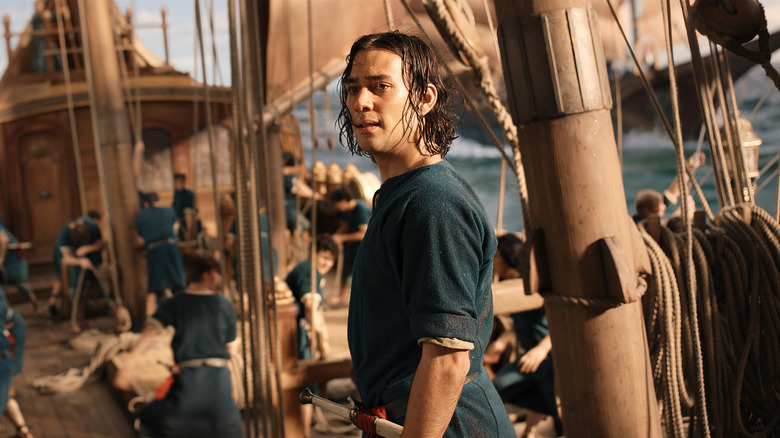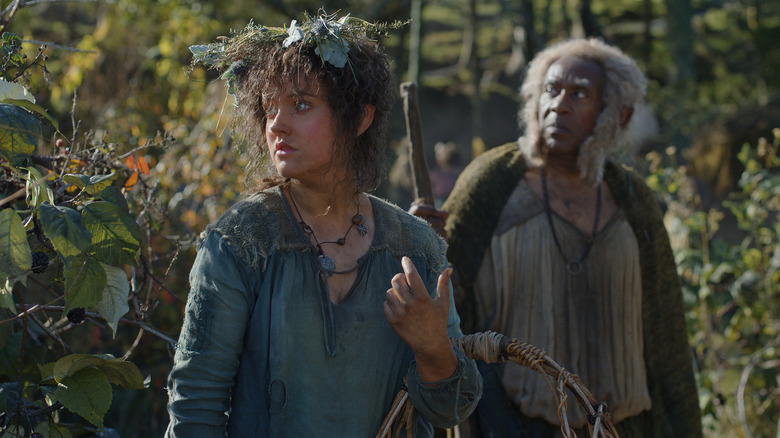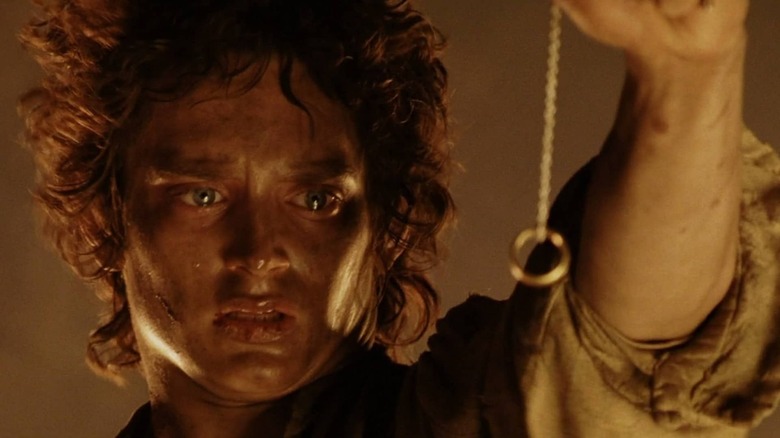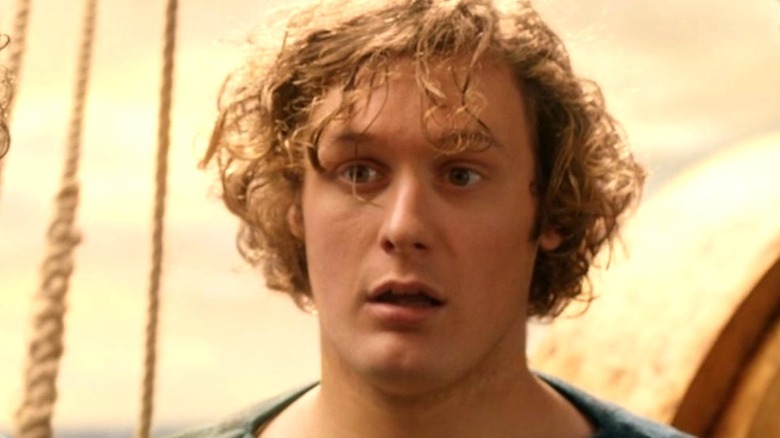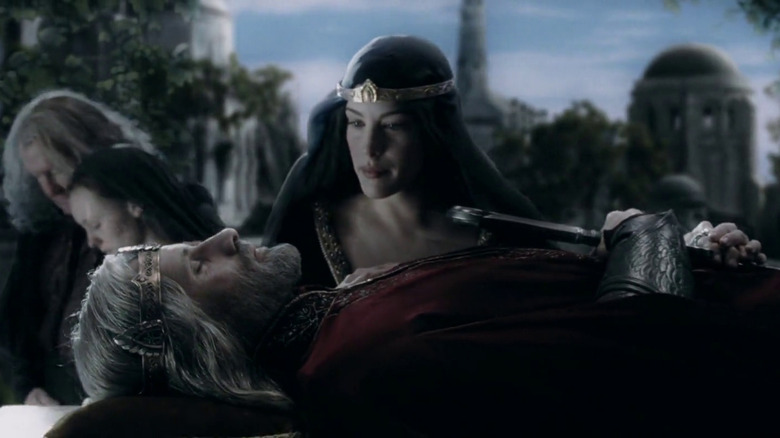Lord Of The Rings Universe Characters Who Died Off-Screen
J.R.R. Tolkien's world is massive, with a sprawling map of Middle-earth that includes numerous towns, cities, countries, and regions. The author found time to create countless characters within these locations, too. Some of these survive his stories; others are killed or pass away during the adventures; and still others die off-screen, leaving the limelight of the primary narrative before they meet their doom.
Let's consider some of the characters who die off-camera throughout Middle-earth history. To avoid a list as long as Frodo's trek to Mordor, we'll restrict the candidates to those within the primary cinematic adaptations (since we're talking about off-screen, not off-page). That leaves us with three primary sources at the time of this writing: Peter Jackson's "Lord of the Rings" and "The Hobbit" trilogies and Season 1 of JD Payne and Patrick McKay's "The Lord of the Rings: The Rings of Power" streaming series.
Within the context of these three gargantuan chunks of film, there are quite a few characters that end up dying, even if we don't realize it during the viewing experience. Here are some of the most interesting of those larger-than-life personalities' fates, presented in no particular order.
Balin, son of Fundin, dies in Moria
Balin, a notable Dwarvish leader and one of the greatest characters in "The Hobbit," has a soft spot for Bilbo and is one of the oldest and most rational individuals in Thorin's company. Balin is portrayed by Ken Stott in all three of Jackson's "The Hobbit" films, and he survives the entire multi-film ordeal. However, by the time we see him in "The Lord of the Rings," he's in a stone casket in the littered ruins of Moria.
How did things go so terribly wrong between the two films? "The Fellowship of the Ring" book tells us that after the events of "The Hobbit," the Dwarves start to think about their old mansion of Khazad-dûm (which, at that point, is a distant memory). The book says, "At last, however, Balin listened to the whispers, and resolved to go." The Dwarf leads a large colony of his people back to Moria during the period between the two stories. At first, they succeed, but eventually, they are overwhelmed by the Orcs and their fiery Balrog leader, who still dwell in the deeps. Balin is killed, and the Dwarves don't even officially know that fact until the Fellowship of the Ring stumbles on his tomb during their trip.
Dáin Ironfoot perishes defending the Lonely Mountain
In "The Hobbit: The Battle of the Five Armies," a fierce army of Dwarves arrives at the Lonely Mountain to bring Thorin and his trapped companions reinforcements. These Dwarves are led by the Dwarven lord Dáin Ironfoot, who is played by Billy Connolly in the movie. The recklessly bold, short-statured warrior leads his troops in battle and, afterward, becomes the King under the Mountain when Thorin dies. He rules that rebuilt kingdom for several decades until the War of the Ring breaks out (i.e., the geopolitical events of "The Lord of the Rings").
While Dáin doesn't show up during Tolkien's storied account of the war, he does his part in the fighting. The appendices of "The Return of the King" book explain that King Dían is one of two kings (the other of whom also makes this list) that stand in Sauron's way in the north. In the additional notes, Gandalf tells Frodo and Gimli, "Now we hear that Dáin has fallen, fighting in Dale again, even while we fought here." He adds that it would be a tragedy if it weren't for the fact that Dáin dies fighting despite being super old, even for a Dwarf (he's over 250 years old by that point). It's a noble death and one that happens out of sight but certainly not out of mind for our "Lord of the Rings" heroes.
Finrod Felagund perishes at the hands of a werewolf
In the opening sequence of the first episode of "The Rings of Power," Galadriel gives us a rapid-fire account of the history of her people, basically condensing the bulk of "The Silmarillion" into a heavily adapted and truncated ten-minute prologue. In the speedy summary, a few things stand out, not the least of which is the death of her brother, Finrod Felagund.
Finrod, played by Will Fletcher, is shown already dead, lying on a stone table covered in a cloth. He's holding his dagger, and he has the mark of Sauron on him, something that has been invented for the show. He also has some nasty claw marks on his arm — which happen to hint at his off-screen death, and it's a nasty one.
In "The Silmarillion," Finrod is captured by Sauron along with several companions, including the human hero Beren, one of Aragorn's ancestors. The future Dark Lord kills off his captives one by one by having a werewolf execute them right in their cell. When the creature comes to kill Beren, Finrod bursts his bonds, and the text says, "he wrestled with the werewolf, and slew it with his hands and teeth; yet he himself was wounded to the death." It's an ending that is as grizzly and badass as any other on this list, and it's a shame it didn't even get a mention in the show. At least we got an Easter egg in the form of the claw marks.
Alfrid Lickspittle is accidentally eaten by a Troll
"The Hobbit: The Battle of the Five Armies" is, in many ways, a hot mess. Most of the film consists of an atrocious sequence of action scenes that just don't jive with Tolkien's higher fantasy feel. One of these awkward and surprisingly grotesque sequences is the death of Alfrid Lickspittle, the conniving servant of the Master of Lake-town who was invented for Jackson's films and played by Ryan Gage on screen.
In the original theatrical version, Lickspittle is sent off by Bard, never to be seen again. However, in the extended edition of the film, we get a disturbing sequence that shows he actually never escapes the battle alive. On the contrary, after hiding in a catapult, the slimy servant accidentally sets the device off, launching himself head-first directly into the mouth of a nearby troll. He suffocates the beast, which, in turn, kills the occupant of its oral cavity when it falls over.
Both Alfrid and his master die in the film — the former initially off-screen before being added to the extended edition and the latter right in the original cut when Smaug falls on his boat. In the books, there is no Lickspittle, and all we hear about the master (right on the last page) is that after stealing most of the gold, he "fled with it, and died of starvation in the Waste, deserted by his companions."
Thráin is vaporized
There are a lot of important Dwarves that die off-screen in Tolkien's writings, likely a symptom of the fact that his stories are supposed to be written from Elf, Hobbit, and Human perspectives. Yet another short-statured ruler who dies elsewhere is Thorin's father, Thráin II. A king in exile, Thráin leads an adventurous life that includes war, nomadic wanderings, and endless family misfortune. Eventually, he tries to return to the Lonely Mountain in much the same way that Thorin and his companions do so later on.
In Thráin's case, though, things go really badly. After countless disruptions and dangers, Thráin himself disappears on the edge of Mirkwood, presumably captured by Sauron's servants and brought to his dark fastness of Dol Guldur. "The Return of the King" appendices tell us, "There he was tormented and the Ring taken from him, and there at last he died."
In Peter Jackson's "The Hobbit: The Desolation of Smaug" film, Thráin's death was initially cut, leaving his final moments off-screen. However, in a deleted scene, we do get to see Jackson's interpretation of events. Gandalf attempts to save the Dwarf leader, but Sauron is too strong, and he nabs the Dwarf, presumably vaporizing him in an instant.
King Brand dies fighting with King Dáin
When the Dwarven King Under the Mountain, Dáin Ironfoot, dies during the War of the Ring, he isn't alone. Gandalf's description of the distant death scene in the "The Return of the King" appendices states that Ironfoot dies "standing over the body of King Brand before the Gate of Erebor until the darkness fell."
This brings an epic off-screen conclusion to the resplendent Middle-earth resumes of not just Dáin but also the king of another line of powerful rulers. King Brand is the grandson of Bard the Bowman — the same hero who is responsible for slaying Smaug in a fiery battle amidst the ruins of Lake-town in "The Hobbit." In "The Fellowship of the Ring," Glóin the Dwarf describes Brand thusly: "He is a strong king, and his realm now reaches far south and east of Esgaroth."
The combined realms of Dale and the Lonely Mountain may not be front and center in "The Lord of the Rings," but they feature fierce fighting and heroic last stands all the same. These have a major impact on the overall story, too, as Gandalf astutely points out in the appendices: "Think of what might have been. Dragon-fire and savage swords in Eriador, night in Rivendell. There might be no Queen in Gondor. We might now hope to return from the victory here only to ruin and ash." Much of this is avoided because of the heroic sacrifices of kings Brand and Dáin.
Uglúk is slaughtered just out of sight
In "The Two Towers," Merry and Pippin are captured and then Orc-dragged across Rohan in a desperate race to reach Isengard before anyone can interfere. At first, their Orc captors appear singularly focused on reaching Saruman's fortress. However, in the films, and even more so in the books, it slowly comes out that there are different factions of Orcs present, each with their own agenda.
A group of Mordor soldiers, led by their captain, Grishnákh, attempt to bring the Hobbits back to Sauron. The others in the group are the Uruk-hai, the tall, powerful race of Orc soldiers bred by Saruman. They are led by Uglúk, a powerful warrior who forces his will on the band and makes them march to Isengard at a run.
Ugluk's attempt to override Sauron's directives in favor of his Wizarding master's commands ends in failure when the Riders of Rohan arrive on the scene and slaughter everyone in sight. In the movies, we see Grishnákh in his final moments before he's Ent-stomped by Treebeard, but Uglúk remains just out of sight, fighting with the Rohirrim until he's overwhelmed and killed. In "The Two Towers" book, we get a little more detail when, as the Orcs try to escape into the forest, it says, "Uglúk was overtaken and brought to bay at the very edge of Fangorn. There he was slain at last by Éomer, the Third Marshal of the Mark, who dismounted and fought him sword to sword."
Saruman and Wormtongue initially die off-screen, too
Saruman and Wormtongue play small but integral roles in "The Return of the King" book. When the Hobbits return home at the end of the story, they discover that they have to clear the Shire of the Wizard and his thugs. In that conflict, both Saurman and Wormtongue die; in the movies, Peter Jackson opted to cut the entire affair.
He also initially chose to leave any resolution regarding the treacherous Wizard and his pitiable companion out entirely. When Saruman actor Christopher Lee discovered that he'd been axed from the theatrical version of "The Return of the King" (which was supposed to open up with his character's death scene), he was so offended that he refused to attend the premiere. In that scene, Saruman falls from the top of his tower to his death after being stabbed by Wormtongue, who is subsequently shot by Legolas. While different, both the book and the extended edition show Saruman being stabbed to death and Wormtongue shot to death by arrows. In the original release of the film, though, both characters perish off-screen.
Isildur's mother drowns
Isildur is one of the most recognizable names in Middle-earth history. He's the one who founds Gondor, cuts the One Ring from Sauron's hand, and keeps it for himself, perishing as a consequence. Aragorn is still using him as a claim to his legitimacy to the throne thousands of years after the man dies. He's a really big deal, guys.
And Isildur's family? They're mostly important, too. Elendil, his father, is another major character in Tolkienian canon, and his brother Anárion is also important, although he doesn't feature much in Tolkien's writings. His sister, Eärien, is made up for "The Rings of Power," but even so, she's had a lot of narrative created for her as well.
The one member of the family who doesn't have much backstory is Isildur's mom. The matriarch of the family literally goes unmentioned in the source material. In the show, we get a little more information, but only in the form of a brief summary of her death. By the time "The Rings of Power" starts, the family of Elendil is already grieving the loss of their still-unnamed mother and wife, who perished at sea before the story starts. How this will impact the character arcs of her relatives remains to be seen, but there's no doubt that it will matter in JD Payne and Patrick McKay's story. Barring a flashback in future seasons, though, it will remain an off-screen death all the same.
A ton of Harfoots die horrible deaths
The Hobbits of "The Lord of the Rings" live quiet, simple lives in the Shire. However, Tolkien makes it clear that this peaceful existence is a relatively recent development. For centuries and millennia before the settling of the Shire, Hobbit ancestors endured harrowing migrations, some of which have been creatively adapted for "The Rings of Power" in the form of the Harfoots.
The wooly-footed race of Halflings is still nomadic and is used to a very hard lifestyle during the Second Age setting of the show, i.e., several thousand years before "The Lord of the Rings." At one point before they begin to migrate, community leader Sadoc Burrows lists off the Harfoots who have died during previous hardships. For instance, one Miles Brightapple froze to death on a mountain; Daffodil Burrow was mauled by wolves; Druda Bumbelly ate the wrong berries; Blovo Bolgerbuck was stung by bees; and most of the Proudfellow family died in a landslide.
The horrendous list of previous deaths is listed one after another in the third episode of Season 1, and it's a tough listen. No wonder this group is so timid and conflict-averse. They've suffered their fair share, and they don't want to go through it again.
Most of the Hobbit Ring-bearers
When you hear "Ring-bearer," it usually brings Frodo Baggins to mind, and Bilbo is another popular ring-carrying Middle-earther. But the list of Halflings who carry the One Ring is actually longer than this dynamic duo. The lost piece of jewelry is initially rediscovered by one Déagol before Sméagol kills him. Bilbo finds it from there and passes it on to Frodo. Sam eventually carries it as well, before saving his master from the Orcs in Mordor and giving it back.
Out of this list, Déagol and Sméagol (aka Gollum) die on screen. However, Frodo and Bilbo sail off into the West, presumably dying at some later point in the immortal lands across the sea. And Samwise? He actually shares in that same fate.
The appendices of "The Return of the King" tell us that "Among [his daughter Elanor's family], the tradition is handed down from Elanor that Samwise passed the Towers, went to the Grey Havens, and passed over Sea, last of the Ring-bearers." He is 102 years old when that happens. And his death? Yeah, that's unknown and off-screen.
Ontamo gets caught by Mount Doom's eruption
"The Rings of Power" is working hard to build up a backstory for the Tolkineian hero Isildur. While the source material has a decent chunk of information on the man once he's older, the show starts back when he's still a relatively young adult. People age slower in Númenor, and the show is changing Tolkien's timeline and pacing of the story, so his specific age is a little bit complicated.
One way Season 1 de-aged Isildur was by giving him a pair of young friends named Valandil and Ontamo. The trio of Númenórean compatriots is clearly "coming of age" together as the story begins. They all sail to Middle-earth as part of the military expeditionary force and ride off to free the Southlands from the invading Orcs. Everything goes well at first, then Mount Doom blows its top.
Valandil and Isildur survive the ensuing fiery carnage, but they discover Ontamo amongst the wreckage — already dead. As a non-canon character created for the show, Ontamo helps round out Isildur's backstory a bit, but his premature death ends his own story before it even gets started, and he doesn't even get the decency of an on-screen death to wrap things up.
Aragorn surrenders his life off-screen
Aragorn is a major character in "The Lord of the Rings." The exiled king helps Frodo through part of his journey before detouring to save Rohan and then his future kingdom of Gondor. When the Ring is destroyed and the dust settles, he's still alive, and he becomes king. So, what's all this about a death scene? In a flash-forward in the movie "The Two Towers," Arwen sees a vision of her dead husband. That means, at different points, we see Aragorn both alive and dead, even though we never actually see him die.
The interesting thing is that this is heavily influenced by a scene in the appendices of "The Return of the King," where Tolkien describes Aragorn's death. After ruling for 120 years together, Aragorn says farewell to Arwen and willingly surrenders his life. The text reads, "'Estel, Estel!' she cried, and with that even as he took her hand and kissed it, he fell into sleep." It goes on to explain, "Then a great beauty was revealed in him, so that all who after came there looked on him in wonder; for they saw that the grace of his youth, and the valour of his manhood, and the wisdom and majesty of his age were blended together." From there, we get the awe-inspiring final line, which says, "And long there he lay, an image of the splendour of the Kings of Men in glory undimmed before the breaking of the world."
